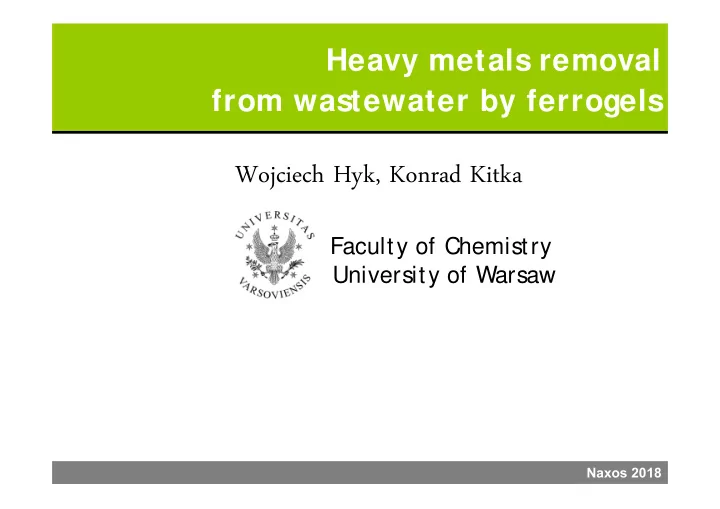

Heavy metals removal from wastewater by ferrogels Wojciech Hyk, Konrad Kitka Faculty of Chemistry University of Warsaw Naxos 2018
The aim • To develop a method for metal removal from waste water samples using thermoresponsive ferrogel sorbents („magnetic sponge”) Wojciec jciech Hyk Hyk
Realization – general scheme • The synthesis procedure of hydrogel matrix for the implementation of a metal sorbent in aqueous systems with strictly defined composition of the sorption system • Gel matrix – thermoresponsive poly(N-isopropylacrylamide) Δ T hydrogel • Metal sorbent – nanosized magnetite (ferromagnetic properties) • Examination of the composite material for silver and copper removal from aqueous media Wojciec jciech Hyk Hyk
Realization - details • Preparation of pNIPA gel swollen by water – free-radical polymerization of N-isopropylacrylamide (NIP A) using well documented procedures • Purification and drying the resulting polymeric material (pNIPA) • Grinding the pNIPA material to a fine powder • Preparation of the ferro-pNIPA system – mixing the pNIP A powder with known amount of nanosized magnetite • Formation of the pNIPA ferrogel swollen by the aqueous solution – transferring the ferro/ pNIP A mixture into the aqueous solution containing heavy metal cations • Aqueous solution purification – inducing volume phase transition of the gel system and removing the collapsed gel by an external magnetic field Wojciec jciech Hyk Hyk
Realization – the idea • Water purification using sponge like behaviour of poly(N- isopropylacrylamide) ferrogels Δ T t B solvent molecule metal cation sorbent particle dry polymer fragment Wojciec jciech Hyk Hyk
Results – silver removal from water samples • Effect of pNIPA matrix on the silver adsorption efficiency magnetite solution 14 pNIP A / magnetite gel 12 10 Q e [mg/g] 8 6 4 2 0 0 50 100 150 1 / m(Fe 3 O 4 ) [1/g] Wojciec jciech Hyk Hyk
Results – silver removal from water samples • Determination of adsorption isotherm A aqueous solution of magnetite – 10 Langmuir isotherm 8 c e (Ag + ) / Q e 6 4 Q max : 9.1 ± 3.4 mg / g 2 0 0 10 20 30 40 50 60 70 c e (Ag + ) [mg/L] B pNIPA / magnetite ferrogel – 0.8 Freundlich isotherm 0.6 log(Q e ) 0.4 Q max : 13.6 ± 3.8 mg / g 0.2 -0.8 -0.4 0.0 0.4 0.8 1.2 1.6 2.0 log(c e (Ag + )) Wojciec jciech Hyk Hyk
Results – mechanism of silver adsorption on magnetite • Chemical reduction of silver (I) cations on the surface of magnetite (silver chemical deposition) • Diffusion of silver (I) cations to iron oxide grains 2Fe 3 O 4 ( s ) + H 2 O + 2Ag + ↔ 3Fe 2 O 3 ( s ) + 2H + + 2Ag( s ) • • Extraction of silver requires concentrated nitric (V) acid Wojciec jciech Hyk Hyk
Method validation for real wastewater samples • Sample prepared to mimic copper ore post - flotation waste c Ag : 100 mg / L Ag(I) 100 c Cu : 664 mg / L 80 60 %R Cu(II) 40 20 0 0 2 4 6 8 10 12 14 16 %(Fe 3 O 4 ) in pNIPA gel Wojciec jciech Hyk Hyk
Conclusions • Synthesis procedure of universal hydrogel matrix for controlled implementation of metal sorbents • Highly efficient silver removal by a “magnetic sponge” (pNIPA / magnetite thermoresponsive ferrogel) • Silver adsorption on magnetite in pNIPA ferrogel is described by the Freundlich model • The presence of gel matrix increases efficiency of silver sorption on magnetite Wojciec jciech Hyk Hyk
Recommend
More recommend